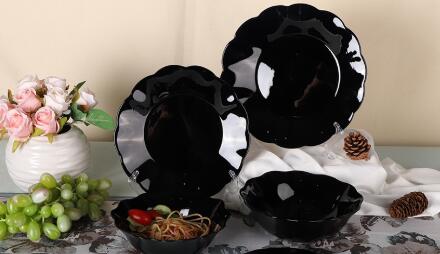The Breaking of the Glass
Pulished on Oct. 16, 2018The Breaking of the Glass
The end of the public wedding ceremony is marked by the breaking of a
glass, usually a thin glass wrapped in a napkin to contain the fragments.
It is smashed under foot by the groom after the seven benedictions, or
after the rabbi’s address if it follows the benedictions. Some customs placed
it after the betrothals, but our western tradition is to perform it at the very end.
Ancient custom designated that one of the wine cups be broken, although
there was a difference of opinion as to which of the two wine cups. Maharil
held that it was the nuptials cups, because the breaking immediately followed
the nuptial blessings. Rema and most others held that it was the betrothal cup,
and for good reason: Breaking the nuptials cup, over which the seven
benedictions were recited, is a gross symbol when great concern at this
moment is for making the marriage, not breaking it. However, once the
nuptials are recited the betrothal has been accomplished, and the breaking
of that cup signifies that the nuptials have been satisfactorily completed. The
author of Match Moshe held that it may be any glass at all. Originally, the
blessing was recited over a glass cup which was then smashed. But when
silver cups began to be used, any other glass was used for breaking. One
commentator held that smashing either of the wine glasses was not an
auspicious sign and that another glass should be used.
The general custom that prevails today at traditional weddings is the use of
a prepared glass or bulb. However, this robs the ceremony of its historic
beauty and significance. Therefore, it is preferable to use a glass goblet for
the betrothals and a silver kiddush cup for the nuptials. Immediately after the
seven benedictions, the rabbi can pour the remaining wine from the glass into
a prepared bowl, wrap it in a cloth napkin and have the groom place it on the
floor and crush it.
Some rabbis were bothered by the problem of bal tashchit, the formidable
principle of not wasting material needlessly, and also of bizayon kos shel
berakhah, the "shaming" of the "cup of blessing" by smashing it. But the
response was that it is neither waste or shame because the very breaking
conveys important moral ideals. What are these ideals?
First, we should note that much has been written on the mythology and also
the psychology of the ceremony. Some of the scholarship is erudite, some
is trivial popularizing, and little of it is of immediate relevance to the theme
of this book. Many scholars find the roots of every Jewish observance or idea
in an alien theology or primitive rite. We are concerned here with the symbol
as it lives today, and the significance we can derive from its practice.
The source for the custom is related in the Talmud. Mar, son of Ravina, made
a wedding feast for his son, and when he noticed that some of the rabbis
became boisterous in their joy, he brought a precious cup worth four hundred
zuz, and smashed it before them. This quieted them down immediately. Rabbi
Ashi also made a wedding feast for his son, and when he noticed that the
rabbis were boisterous, he brought a cup of white glass and smashed it before
them and immediately they sobered. Rashi said the breaking was of a white
wine cup and that only that kind of glass could be used for the ceremonial
breaking; theTosafists derived from this the prevalent custom of breaking any
glass utensil at every wedding service.
What is the reason? From the Talmud it would appear that breaking the glass
served to engender sobriety and balanced behavior. Psalms 2:11 says,
"Serve the Lord with fear, and rejoice with trembling". Rabbi Ada ben Matanah,
interpreted in Rabbah’s name: Bime’kom gilah, sham te’hei re’adah, "Where
there is rejoicing, there should be trembling." A wedding should not be sheer
undisciplined merriment, and the breaking of expensive glass stunned the
guests into tempering their gaiety. The ceremony serves, then, to moralize
pleasure and attain tempered emotions.
In the fourteenth century, the author of Kol Bo offered another explanation.
The broken glass represents the wreckage of our past glory, and the
destruction of the ancient Temple in Jerusalem in the first century. It recalls,
at the most joyous and momentous occasion of the life cycle, that there is a
continuing national sadness. It is a memory of Zion that stands as a reminder
that in life great joy can be cancelled by sudden grief. It enriches the quality
of joy by making it more thoughtful and by inspiring gratitude for the goodness
of G-d.
It is customary to recite the following words when breaking the glass: "If I forget
Thee, O Jerusalem, may my right hand fail... at the height of my joy." Sephardic
Jews, and also many of Ashkenazic descent, recite this phrase at the
performance of an analogous custom during the wedding, the placing of
a bit of ash on the groom’s forehead. This sign of mourning is placed at
the site of thetefillin—the ash of bereavement (efer), in place of the glory
which signifies tefillin(pe’er).
Perhaps a deeper significance can be realized if, as the groom’s action
recalls the demolished house of G-d, the now-married couple takes it as
an obligation upon themselves to rebuild the Temple in their own lives by
building their own Jewish home, as every synagogue is a mikdash meat,
a miniature temple. The Sages say that all that is left of the Temple today
are dalet amot shel Halakhah, (the four ells of Torah law). If the home we
build will house the spirit and practice of these four ells, we will have
contributed to the rebuilding of the Temple in our own way and in our own
homes.
How unfortunate it is, therefore, that the phrase of Jerusalem’s destruction
is rarely recited and, instead, a chorus of mazal tov’s greets the breaking
of the glass. If the reason for the glass breaking is to temper joy, this is
surely inappropriate; if the reason is to recall a national tragedy, it is vulgar.
Often not only is a joyous mazal tov sounded, but a licentious sneer that it
is a "good sign" if the glass is smashed at the first try. This elicits gross
comments regarding the groom’s prowess. The late Sephardic Chief Rabbi
of Israel, Ben Zion Ouziel, wished that he could have abolished the custom
for this very reason. In fairness, however, it should be noted that the mazal tov
is not so much in response to the breaking of the glass, as it is to the end of
the ceremony. In any case, it would be less than responsible to eliminate a
millennial tradition because of some people’s untutored reaction to it. Perhaps
we should reinstitute the reference to Jerusalem and move the glass breaking
back to the middle of the wedding ceremony.
The two fundamental reasons lead us to another insight derived from this
ceremony—the magnificent, sensitive balance within Judaism that testifies
to its rich maturity and to its suitability to the whole range of human emotions.
It connects the private moment under the chuppah with the public national
event of the Temple, the ancient past with thoughts of a long future, heady
joy with a tragedy bewailed for nineteen hundred years. The breaking of a
glass at the symbolic moment that celebrates making a new home, is also
reminiscent of the Talmud’s assertion that "joining two people in marriage
is as difficult as splitting the sea."
Through the ages, other homilies were derived from the ceremony. Tzafenat
Pa’neah suggests the hope that the breach in the relation between G-d and
Israel caused by the Temple’s destruction will be repaired just as a broken
glass can be repaired by melting under the glazier’s fire. G-d’s marriage with
the Jewish people will be unbroken, as will the marriage of these children of
G-d to one another.
Rabbi Bachya traces this custom, as so many other marriage customs, to the
revelation on Sinai. What joy is greater than the wedding, in the private lives
of this bride and groom? What joy is greater in the religious lives of the people
Israel than the simchat Torah, the exquisite moment at Sinai? At Sinai, there
was the tragic breaking of the tablets of the commandments at the foot of the
mountain; at the wedding simchah there is a symbolic breaking of the glass
under foot. Every new family helps repair the breach at Sinai—the breaking,
in joy, at every wedding overcomes the breaking of the tablets.
Contemporary preachers have suggested new meanings for this closing
ceremony. The fasting in repentance before the wedding and the purification
from the stains of the past in the mikveh is symbolized in the crushing of the
glass, which represents a final, dramatic breaking with the past. A full life is
the cup from which we drink. It is a "cup of blessing," one which we use to
celebrate Sabbaths and festivals. A life that is filled to the brim with meaning
is the life for which we strive.









